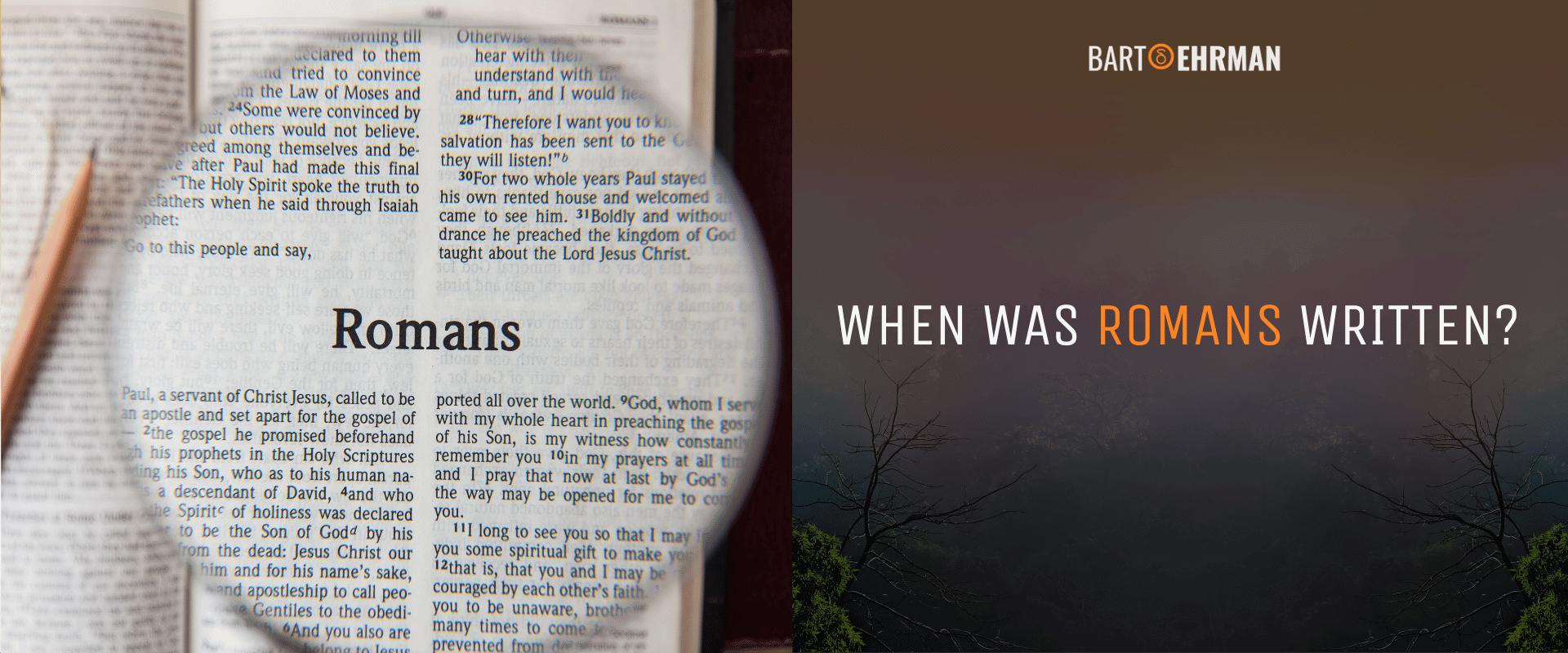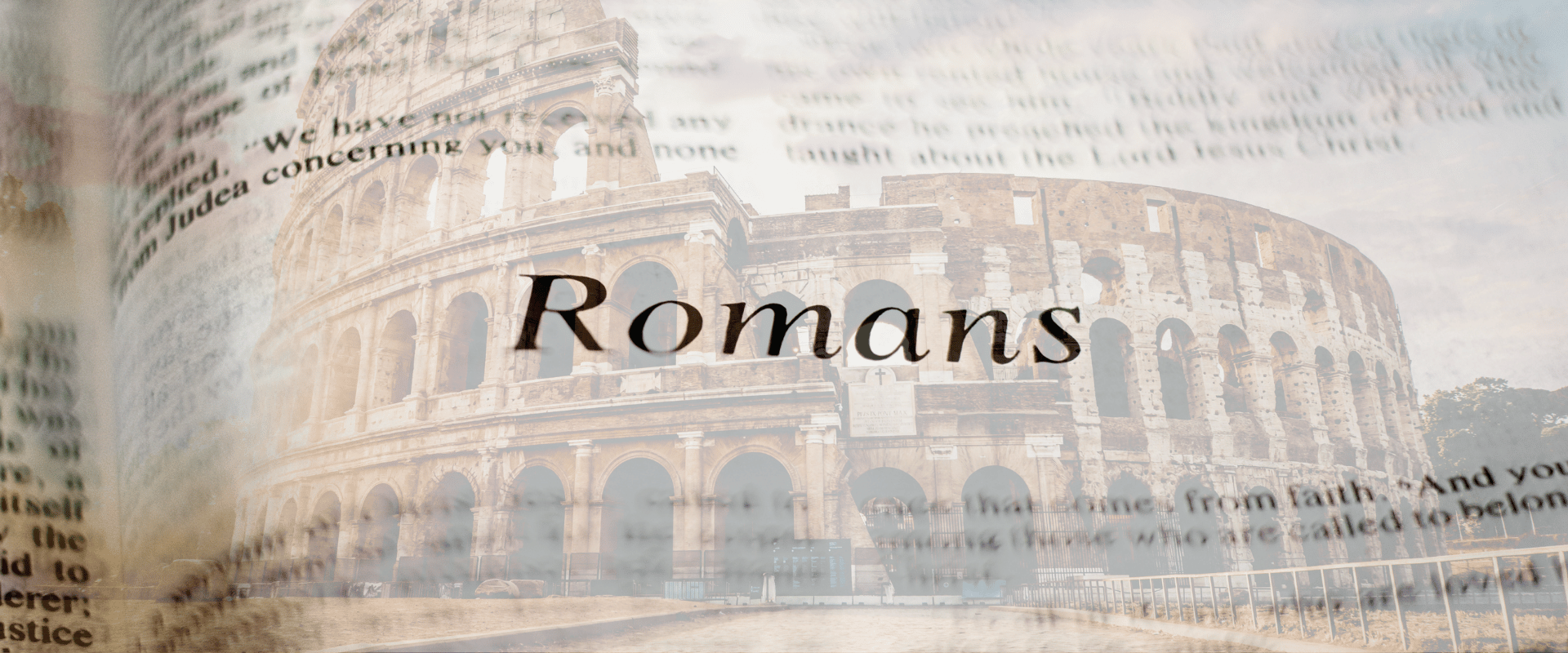When Was Romans Written?

Written by Marko Marina, Ph.D.
Author | Historian | BE Contributor
Verified! See our guidelines
Verified! See our editorial guidelines
Date written: June 27th, 2024
Disclaimer: The views and opinions expressed in this article belong to the author and do not necessarily match my own. - Dr. Bart D. Ehrman
Among all the epistles in the Bible, the Book of Romans stands apart from other New Testament documents because it influenced the conversion process of one of the most important Christian theologians that ever lived: St. Augustine.
Moreover, Bart Ehrman notes in The New Testament: A Historical Introduction: “The letter to the Romans is unique among Paul’s writings and arguably the most important. It’s the only letter Paul wrote to a church that he did not himself establish, and it’s the only letter that does not explicitly try to solve the church’s problems.”
Given its unique characteristics and profound impact on Christian theology, understanding the context in which Romans was written is crucial. In this article, we will delve into the historical and scholarly perspectives to address the question: When was Romans written?
By examining the origins of the Christian community in Rome, its relationship with Paul, the historical context of Paul’s missionary journeys, and the scholarly debates surrounding the letter's date, we aim to provide a comprehensive overview of the composition of this seminal epistle.
Our approach will be scholarly, yet accessible, maintaining a friendly and respectful tone throughout. We’ll first summarize the Epistle to the Romans and discuss its authorship.
Then, we’ll explore Paul's connections to the Roman community and reconstruct the likely timeframe of the letter's composition based on available evidence. This examination will not only enhance our understanding of the Epistle, but highlight its enduring significance in Christian history.
So, join us as we embark on this journey to uncover the historical background and timing of one of the New Testament’s most influential writings.

The Epistle to the Romans: Authorship and Summary
The authorship of the Epistle to the Romans is attributed to the Apostle Paul, a fact widely accepted among scholars. In his Commentary on Romans, Joseph Fitzmyer notes: “Although the authorship of Romans has been questioned at times in the not-too-distant past, modern students of the letter almost unanimously agree about its Pauline authenticity.”
Check out our earlier article to learn more about the arguments favoring traditional attribution.
The book for Romans is one of the New Testament's most theologically rich and complex letters. At its core, the letter addresses the themes of sin, salvation, grace, faith, righteousness, and the relationship between Jews and Gentiles in God's plan.
As Raymond E. Brown notes in An Introduction to the New Testament: “Righteousness is the key idea in Pauline thought, and in Romans, it's expressed in several terms... For Paul, there was in Jesus a greater, eschatological manifestation of God's righteousness, extended to all.”
Throughout the letter, Paul systematically outlines the doctrine of justification by faith, emphasizing that righteousness comes from God through faith in Jesus Christ, rather than through the Mosaic Law.
This message is foundational to Christian theology and has profoundly influenced the religion’s thought and practice. While this summary is brief, we’ll delve into the detailed theological discussions and summary of Romans in a future article.
When Did Paul Write Romans?
When was Romans written? To answer that, we must take a look at the origin of Christianity in Rome and Paul’s relationship with the Christian community there. Only through the broader context can we track — step-by-step — Paul’s chronology, thus finding out when he wrote the Epistle to the Romans.
The Origins of Christianity in Rome
The origins of the Christian community in Rome are quite mysterious. Contrary to traditional beliefs of the Catholic Church, there is no solid evidence that the Apostle Peter founded it.
Similarly, it’s clear from Romans 15:20 that the Apostle Paul didn’t establish a community there. Instead, Christianity likely reached Rome through the spread of the good news by travelers from across the Empire. The capital city, bustling with people from all over, provided fertile ground for the new religion to take root.
Moreover, Rome already had a significant Jewish population by the end of the 1st century B.C.E. Joseph Fitzmyer estimates that around fifty thousand Jews lived in Rome, organized into several synagogues. Many were brought to Rome as slaves by Pompey following his eastern conquests, particularly after he captured Jerusalem in 63 B.C.E.
This substantial Jewish presence provided a foundation for the early Christian community, which included many Jews who believed in Jesus’ messianic identity and resurrection.
They maintained ties with their homeland, making it likely that the message of Jesus’ resurrection reached Rome via Jewish travelers. Some scholars even highlight the importance of Puteoli, a major port near Rome, as a key entry point for Judaism and Christianity into the capital.
Peter Lampe, in his study From Paul to Valentinus, observes: "That Judaism and Christianity made their way to Rome through Puteoli, through this urbs Graeca and Italy's gateway to the orient, was typical of the entrance of Eastern religions into the world's capital city."
Therefore, it’s plausible that the Christian community in Rome had its roots in the Jewish community, possibly as early as the 30s C.E. The first known document to acknowledge its existence is the Epistle to the Romans itself.
Paul mentions that this community has existed "for many years" (Romans 15:23). While it’s unclear whether he meant this literally or was using a bit of rhetorical flourish, most scholars agree that Christianity had an established presence in Rome shortly after Jesus' death.
In any case, Paul’s letter to the Romans, written to a community he had not yet visited, reflects his interest in that community and his desire to support and — most importantly — instruct them about the Gospel’s essence.
With this context in mind, we can now turn our attention to the crucial question: When did Paul write Romans?
FREE COURSE!
WHY I AM NOT A CHRISTIAN
Raw, honest, and enlightening. Bart's story of why he deconverted from the Christian faith.
Over 6,000 enrolled!
Dating Romans: Remarks on Methodology and Sources
Pinning down the exact dates for Paul's letters is a formidable task for historians. The primary challenge exists because any attempt to reconstruct Paul's timeline relies heavily on the information provided in the Acts of the Apostles. As the only book that covers the development of Christianity in the first decades following Jesus’ death, the Book of Acts is indispensable for understanding Paul’s life.
This, naturally, raises questions about the historical accuracy of Luke's second volume. Scholars frequently highlight the numerous historical inaccuracies (e.g. the unlikely rate of conversion in the first few chapters that suggest massive numbers of people became Christians on the spot) and the ideologically driven agenda within Luke's narrative.
As French scholar Daniel Marguerat aptly puts it in his fascinating study The First Church Historian: "Luke is situated precisely at the meeting point of Jewish and Greek historiographical currents. His narrative devices are heavily indebted to the cultural standard of the Roman Empire, that is, history as the Greeks wrote it. However, contrary to the ideal of objectivity found in Herodean and Thucydidean historiography, Luke recounts a confessional history… Judeo-Christian historia has no other ambition than to point to God behind the event."
Despite these challenges, we have to work with the sources available. Historians often find themselves in a tricky spot, trying to piece together accurate timelines from texts that blend history with theological storytelling.
As we dive into the task of dating the Epistle to the Romans, we must navigate these complexities and rely on the somewhat questionable but indispensable information provided by Acts. So, let’s take a closer look at the available evidence and see how it helps us determine when Paul might have penned this crucial letter.

The Epistle to the Romans: Paul’s Chronology and Date of Composition
Establishing the exact date when Paul wrote the Epistle to the Romans is a complex task that involves piecing together various historical clues. According to most contemporary scholars, Paul wrote this letter during the winter of 56/57 C.E.
Where was Paul when he wrote Romans? He was probably in Corinth (modern-day Greece) and on his way to Jerusalem, intending to reach Spain.
This timing and location are based on several interconnected pieces of evidence.
Firstly, Paul mentions to the Christians in Rome that he has completed his missionary work between Jerusalem and Illyria and now wants to visit Rome to gain support for his planned mission in Spain (Romans 15:19, 23-24, 28). However, before heading to Rome, he needed to go to Jerusalem to deliver a collection of money from the churches in Macedonia and Achaia (Romans 15:25-28).
This information aligns with Luke's account in the Acts of the Apostles. An inscription found in Delphi dates the proconsulate of L. Junius Gallio in Achaia to 51/52 C.E., indicating that Paul was in Corinth around 51 C.E. (Acts 18:1-17).
If we assume the Jews in Corinth brought Paul before Gallio shortly after he took office in mid-51 C.E. (Acts 18:12-17), it’s plausible that Paul left Corinth in the autumn of 51 C.E.
From there, he traveled to Jerusalem and then to Antioch, where he likely spent the winter of 51/52 C.E. (Acts 18:22-23).
Paul then departed for Ephesus in the spring of 52 C.E., where he conducted missionary work for more than two years (Acts 19:8, 10), likely concluding around 55 C.E. At the end of his stay in Ephesus, he planned to travel through Macedonia and Achaia to Jerusalem and then to Rome (Acts 19:21). He followed this plan, moving from Ephesus to Macedonia and then to Achaia (Acts 20:1-2).
In a letter to the Corinthians, Paul explains why he had to delay his visit to Corinth, writing from Macedonia. He mentions his extended stay in Macedonia several times (2 Corinthians 1:16; 2:13; 7:5; 8:1-5; 9:2), indicating he was there longer than expected. Consequently, Paul likely reached Corinth in 56 C.E., rather than a year earlier as originally planned.
The author of Acts also records that Paul stayed in Achaia for three months before leaving for Syria (Acts 20:3). Moreover, Paul intended to be in Jerusalem by the Feast of Pentecost, which fell on May 29, 57 C.E. (Acts 20:16). Therefore, his three-month stay in Achaia can be dated to the winter of 56/57.
Additionally, the Epistle to the Romans was delivered by Phoebe, a member of the church in Cenchreae, one of Corinth's port cities (Romans 16:1-2).
However, in his Commentary on Romans, Robert Jewett calls for a more nuanced position on Phoebe’s role: “Most commentators assume that Phoebe had agreed to be the letter bearer, but a person of her social class would have her scribe read the letter aloud on her behalf.”
A possible solution is that Tertius, who identifies himself in 16:22 as the secretary who is working “in the Lord,” was the one who carried the letter to the community of Christians in Rome. This connection, along with other mentioned chronological steps, supports the conclusion that Paul wrote the letter in Corinth during the winter of 56/57 C.E.
Now, to avoid getting tangled up in ancient travel itineraries and festival schedules, let's break it down with a handy table. Think of it as Paul's travel blog, minus the selfies and food pics!
Year | Event |
|---|---|
51 C.E. | Paul in Corinth (Galio inscription in Delphi) |
51/52 C.E. | Paul likely in Jerusalem and Antioch (winter) |
Spring 52 C.E. | Paul departs for Ephesus (over 2 years of missionary work) |
55 C.E. | Paul’s mission in Ephesus concludes |
56 C.E. | Paul reaches Corinth (delayed visit) |
Winter 56/57 C.E. | Paul stays in Achaia for three months (writes Romans) |
57 C.E. | Paul aims to be in Jerusalem by Pentecost |
Not all scholars are on board with this timeline. Some propose an even earlier date for the composition of Romans. For example, Raymond E. Brown mentions that according to the Revisionist chronology (a theory that a smaller but articulate group of scholars advocate), Paul might have written Romans in 55 or 56 C.E. But then again, a wide consensus among scholars is as rare as a sunny day in London!
Conclusion
When was Romans written? Determining its precise date remains a complex and debated task among scholars. Most contemporary researchers agree that Paul wrote this influential letter during the winter of 56/57 C.E. while in Corinth, en route to Jerusalem.
This dating aligns with multiple historical markers, including the proconsulate of L. Junius Gallio in Achaia and Paul's extended missionary activities in Ephesus, Macedonia, and Achaia, as documented in Acts and his epistles.
Paul's detailed plans, such as his intention to visit Jerusalem before heading to Rome and Spain, combined with the delivery of the letter by Phoebe from the port city of Cenchreae, support this timeframe.
Despite these assumptions and arguments, some scholars advocate for earlier dates, such as 55 or 56 C.E., highlighting the ongoing debates in Pauline chronology. Indeed, achieving a wide scholarly consensus remains challenging, which underscores the dynamic and evolving nature of New Testament studies.
FREE COURSE!
WHY I AM NOT A CHRISTIAN
Raw, honest, and enlightening. Bart's story of why he deconverted from the Christian faith.
Over 6,000 enrolled!
